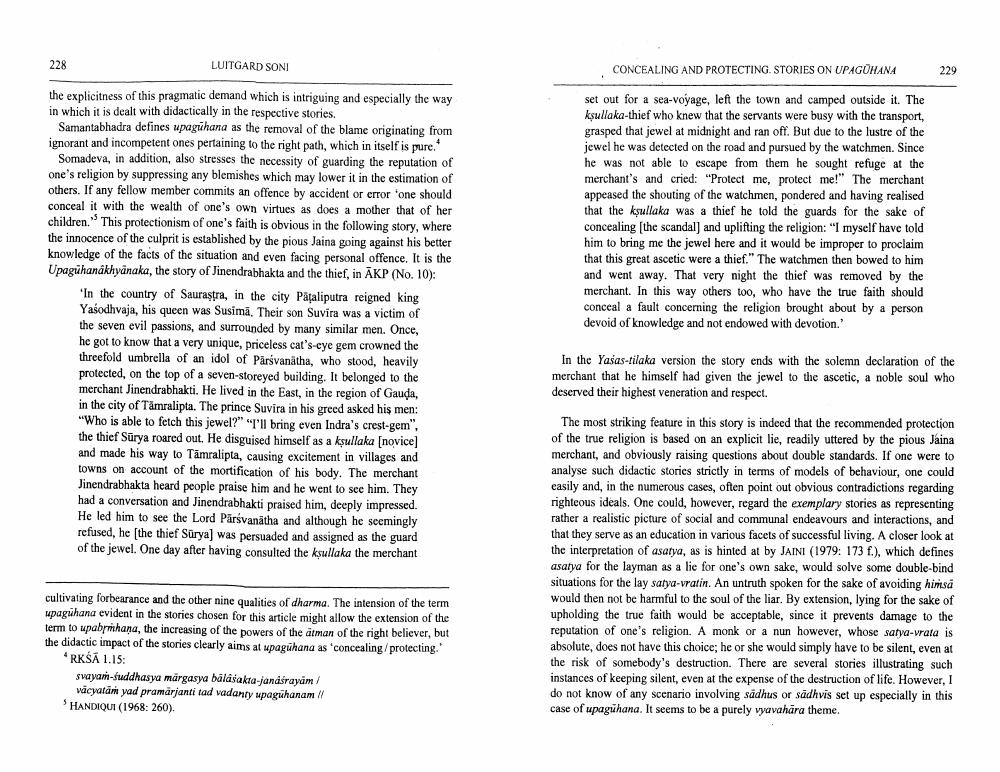Book Title: Concealing And Protecting Stories On Upagahana Author(s): Luitgard Soni Publisher: Luitgard Soni View full book textPage 2
________________ 228 LUITGARD SONI CONCEALING AND PROTECTING. STORIES ON UPAGŪHANA 229 the explicitness of this pragmatic demand which is intriguing and especially the way in which it is dealt with didactically in the respective stories. Samantabhadra defines wpagūhana as the removal of the blame originating from ignorant and incompetent ones pertaining to the right path, which in itself is pure. Somadeva, in addition, also stresses the necessity of guarding the reputation of one's religion by suppressing any blemishes which may lower it in the estimation of others. If any fellow member commits an offence by accident or error 'one should conceal it with the wealth of one's own virtues as does a mother that of her children. This protectionism of one's faith is obvious in the following story, where the innocence of the culprit is established by the pious Jaina going against his better knowledge of the facts of the situation and even facing personal offence. It is the Upaguhanakhyānaka, the story of Jinendrabhakta and the thief, in AKP (No. 10): 'In the country of Saurastra, in the city Papaliputra reigned king Yasodhvaja, his queen was Susimā. Their son Suvira was a victim of the seven evil passions, and surrounded by many similar men. Once, he got to know that a very unique, priceless cat's-eye gem crowned the threefold umbrella of an idol of Pārsvanatha, who stood, heavily protected, on the top of a seven-storeyed building. It belonged to the merchant Jinendrabhakti. He lived in the East, in the region of Gauda, in the city of Tamralipta, The prince Suvira in his greed asked his men: "Who is able to fetch this jewel?" "I'll bring even Indra's crest-gem", the thief Sürya roared out. He disguised himself as a kşullaka (novice] and made his way to Tämralipta, causing excitement in villages and towns on account of the mortification of his body. The merchant Jinendrabhakta heard people praise him and he went to see him. They had a conversation and Jinendrabhakti praised him, deeply impressed. He led him to see the Lord Pärávanātha and although he seemingly refused, he (the thief Surya) was persuaded and assigned as the guard of the jewel. One day after having consulted the kşullaka the merchant set out for a sea-voyage, left the town and camped outside it. The kşullaka-thief who knew that the servants were busy with the transport, grasped that jewel at midnight and ran off. But due to the lustre of the jewel he was detected on the road and pursued by the watchmen. Since he was not able to escape from them he sought refuge at the merchant's and cried: "Protect me, protect me!" The merchant appeased the shouting of the watchmen, pondered and having realised that the kşullaka was a thief he told the guards for the sake of concealing the scandal) and uplifting the religion: "I myself have told him to bring me the jewel here and it would be improper to proclaim that this great ascetic were a thief." The watchmen then bowed to him and went away. That very night the thief was removed by the merchant. In this way others too, who have the true faith should conceal a fault concerning the religion brought about by a person devoid of knowledge and not endowed with devotion.' In the Yasas-tilaka version the story ends with the solemn declaration of the merchant that he himself had given the jewel to the ascetic, a noble soul who deserved their highest veneration and respect. The most striking feature in this story is indeed that the recommended protection of the true religion is based on an explicit lie, readily uttered by the pious Jaina merchant, and obviously raising questions about double standards. If one were to analyse such didactic stories strictly in terms of models of behaviour, one could easily and, in the numerous cases, often point out obvious contradictions regarding righteous ideals. One could, however, regard the exemplary stories as representing rather a realistic picture of social and communal endeavours and interactions, and that they serve as an education in various facets of successful living. A closer look at the interpretation of asatya, as is hinted at by JAINI (1979: 173 f.), which defines asatya for the layman as a lie for one's own sake, would solve some double-bind situations for the lay satya-vratin. An untruth spoken for the sake of avoiding himsa would then not be harmful to the soul of the liar. By extension, lying for the sake of upholding the true faith would be acceptable, since it prevents damage to the reputation of one's religion. A monk or a nun however, whose satya-vrata is absolute, does not have this choice; he or she would simply have to be silent, even a the risk of somebody's destruction. There are several stories illustrating such instances of keeping silent, even at the expense of the destruction of life. However, I do not know of any scenario involving sadhus or sadhvis set up especially in this case of upaguhana. It seems to be a purely vyavahara theme. cultivating forbearance and the other nine qualities of dharma. The intension of the term upagühana evident in the stories chosen for this article might allow the extension of the term to upabrihana, the increasing of the powers of the atman of the right believer, but the didactic impact of the stories clearly aims at upaguhana as concealing protecting." * RKSĀ 1.15: svayam-fuddhasya margasya balasakta-jandirayam vacyatan yad pramarjanti tad vadanty wpaguhanam HANDIQUT (1968: 260)Page Navigation
1 2 3 4 5 6
